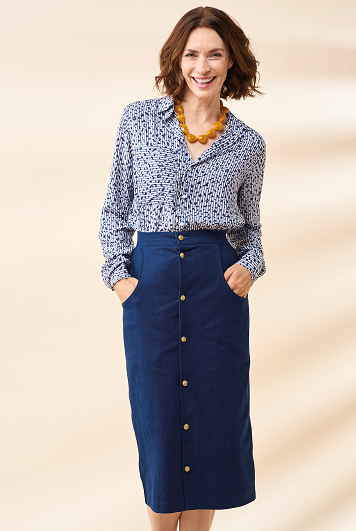THE DENIM DEBRIEF: A Brief History of Denim
denim, dressmaking, history, sewing
2021

Jeans, jeggings, jackets… we can’t get enough of these closet classics, but when it comes to making our own, it’s easy to see why dressmakers can find denim a little daunting. From the outset there’s lots to delve in and learn about, whether it’s the importance of choosing the correct needle and pins to dealing with bulky seams and decorative topstitching. True material aficionados will also be pondering the best wash for their wardrobe, too – acid rinse, anyone? But for the resilient stitchers among us, this fabric is worth staying the course with, as once you’re armed with a few basic tools and some extra sewing know-how, you’ll be able to tackle this heavyweight head-on without breaking the bank – or your machine!
RINSE AND REPEAT

While denim is traditionally known for its deep indigo colour and off-white underside, workers soon started to get creative with the dyeing process to create a whole variety of blue hues for eager stitchers to get their hands on. Raw – also known as dry – denim is kept unwashed after it’s been dyed, meaning the fabric feels stiff and rough to the touch but with wear, it will gradually ‘break in’ to suit your shape; experts recommend holding off throwing it in the washing machine for as long as possible!

Mid-to light-wash denim, meanwhile, undergoes a much longer washing process to remove the excess indigo and create a paler shade; less dye also means the material is much softer from the outset. Popularised in the 1980s, the acid-wash look is another widely-used rinse where the fabric has been treated with chlorine and pumice to create a random marbled effect; the pumice helps to create some natural abrasions on the surface, too.
THE LEVI’S LOOK

Nestled in the heart of southern France, the city of Nîmes (or serge de Nîmes) is the place that birthed this timeless textile; beady-eyed readers may have already spotted that ‘de nimes’ inspired the name that it’s universally known by. However, it wasn’t until the American Gold Rush in the nineteenth century – some 4,000 miles from its origin – that denim took the spotlight, all thanks to its hard-wearing nature that could withstand the punishing conditions of the mines.

Seeing a gap in the market, savvy businessman Levi Strauss decided to open
up a shop in San Francisco, stocking buttons, threads and heavy-duty trousers with deep pockets for storing nuggets of gold. Together with his customer Jacob Davis, who had pushed for copper rivets to be added to the seams and pocket corners for added strength, the two men began to mass-produce jeans under the brand Levi’s, transforming the garment into the beloved classic it is today.
BE A JEANS QUEEN
You’ve settled on your shade of choice, but what’s next on your journey to jeans? Read on for our seven-step guide…
You can find loads more fab tips, tricks and techniques in our How To Sew section. Plus, check out the huge range of free dressmaking, accessories, homeware and gift projects we have to offer!
Don’t forget to follow us on social media! We’re on Facebook, Twitter, Instagram and Pinterest
New this week
.jpg)
Quick Quilting & Patchwork Patterns and Inspiration
9 Apr 2025
[includes sponsored content] From small pieced projects to statement throws, these patterns and products…

Easy Ways To Get Kids Sewing!
11 Mar 2025
[contains sponsored content] Share your love of sewing with a young one and give…

Creative Book Awards 2025 Shortlist Unveiled!
17 Jan 2025
Welcome to the Creative Book Awards 2025! Since launching in 2021, these awards…
